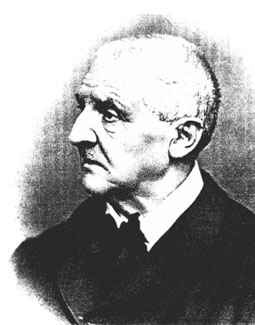| Anton Bruckner  AKA Josef Anton Bruckner AKA Josef Anton Bruckner
Born: 4-Sep-1824
Birthplace: Ansfelden, Austria
Died: 11-Oct-1896
Location of death: Vienna, Austria
Cause of death: unspecified
Remains: Buried, St. Florian Church, Linz, Austria
Gender: Male
Religion: Roman Catholic
Race or Ethnicity: White
Sexual orientation: Straight
Occupation: Composer Nationality: Austria
Executive summary: Mass in D Minor Austrian musical composer, born on the 4th of September 1824 at Ansfelden in upper Austria. He successfully competed for the organistship for Linz Cathedral in 1855. In 1867 he succeeded his former master of counterpoint, Sechter, as organist of the Hofkapelle in Vienna, and also became professor in the conservatory. In 1875 he was appointed to a lectureship in the university. His most striking talent was shown in his extemporizations on the organ. His success in an organ competition at Nancy in 1869 led to his playing in Paris and London (six recitals at the Albert Hall, 1871). His permanent reputation, however, rests on his compositions, especially his nine symphonies. In these gigantic efforts the influence of Richard Wagner is paramount in almost every feature of harmony and orchestration; and if sustained seriousness of purpose and style were all that was necessary to give coherence to works in which these influences are stultified by the rhythmic uniformities of an experienced improvisatore and the impressions of classical form as taught in schools, then Bruckner would certainly have been what the extreme Wagnerian party called him, the symphonic successor of Ludwig van Beethoven, or the Wagner of the symphony. But their lack of organization and proportion, to say nothing of humor, will always make their revival a somewhat severe task. No composer has ever been more consistent to lofty ideals, though few who have ever had an ideal have shown less adroitness in their methods of embodying it. The most poetic and admired feature of his style is a slow growth to a gigantic climax, slow enough and gigantic enough for any situation in Wagner's Nibelungen tetralogy. The symphonies in which these climaxes occur are in obviously unskilful classical form, with only an outward appearance of freedom; and the Great Pyramid would hardly be more out of place in an Oxford quadrangle than Bruckner's climaxes in his four-movement symphonies with their "second subjects" and recapitulations. Nor is it likely that Bruckner would have been much more successful in handling these gigantic things in their legitimate Wagnerian dramatic environment, for even in his last three symphonies he hardly ever frees himself from the trammels of square rhythm; and, as he accepts the classical sonata-forms without inquiry into their meaning or relevance, so he accepts the Wagnerian stage orchestra in its minutest details, without inquiry as to its relevance for the purposes and acoustics of the concert-room, and with the same lack of sense of relief that ruins the balance of his rhythmic periods. So unsophisticated a temperament may be not unpoetical, but it is eminently undramatic, as well as unsymphonic. Of Bruckner's choral works, which include three masses and several psalms and motets, the most famous is the Te Deum (1885), which shows his characteristic power in massive effect. Bruckner wished this to be appended to the three complete movements of his 9th symphony, which his last illness (ending in his death at Vienna on the 11th of October 1896) prevented him from finishing. This 9th symphony is designed, with characteristic tactlessness and simplicity, to follow Beethoven's 9th symphony in every possible point which could challenge comparison; in key (D minor), opening (mysterious tremolo leading to tremendous unison tutti), contrasts (return in first movement) and choral finale. The three complete movements were first performed in Vienna in 1903, and have done more for Bruckner's fame than anything since the production in 1884 of his 7th symphony (of which the slow movement is an elegy on the death of Wagner). It is probable that the impression produced by this 9th symphony is the deeper as owing little or nothing to the musical politics which had gone far to prevent the 7th symphony from standing on its own unmistakable merits. It does not, however, seem likely that Bruckner's work will have much influence on musical progress; for the modern characteristics in which its strength lies are obviously better realized in other forms which have often been handled successfully by composers greatly Bruckner's inferiors both in invention and sincerity.
Father: (schoolmaster, d. 1837)
Teacher: St. Florian Monastery School (ten years)
Professor: Vienna Conservatory (1868-)
Professor: University of Vienna (1875-)
Nervous Breakdown 1866
Do you know something we don't?
Submit a correction or make a comment about this profile
Copyright ©2019 Soylent Communications
|